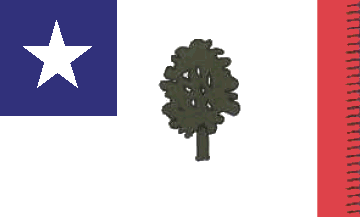 by Clay Moss, 28 December 2005
by Clay Moss, 28 December 2005
Last modified: 2006-07-29 by rick wyatt
Keywords: mississippi | united states | bonnie blue | magnolia |
Links: FOTW homepage |
search |
disclaimer and copyright |
write us |
mirrors
Official Fimbriated Version
 by Clay Moss, 28 December 2005
by Clay Moss, 28 December 2005
Non-fimbriated Version
 by Mario Fabretto, 24 February 1998
by Mario Fabretto, 24 February 1998
See also:
In 1818, five stars were added, representing Indiana, Louisiana, Mississippi, Ohio and Tennessee, bringing the total number of stars on the U.S. flag to 20. There were thirteen stripes representing the thirteen original colonies.
'They recommended for the flag one with width two-thirds its length; with the union square, in width two-thirds of the width of the flag; the ground of the union to be red and a broad blue saltier [sic] thereon, bordered with white and emblazoned with thirteen (13) mullets of five-pointed stars corresponding with the number of the original States in the Union; the field to be divided into three bars of equal width, the upper one blue, the center one white and the lower one, extending the whole length of the flag, red--the national colors; the staff surmounted with a spear head and a battle-axe below; the flag to be fringed in gold and the staff gilded with gold.'Many problems arise because the description would allow for stars to be placed anywhere on the saltire (even all on one arm of the saltire) and still be valid as an official state flag. However, the greater debate is whether there should be a fimbriation or none. A fimbriation is not mentioned, but the clear implication of the drafters was to reinstall (or fondly remember) the Confederate flag. The current flag, regardless of its declared symbolism, is an attempt to combine the national flags of the Confederacy in a new way. In the past, it was quite common to see both fimbriated and non-fimbriated flags flying over the Mississippi capitol.
I just came home from a road trip that included a week in Mississippi and can
report that I saw not a single state flag flying anywhere in the state that
lacked the fimbriation around the canton. The only non-fimbriated Mississippi
flag I saw on the entire trip was in a display of all 50 state flags at the USS
Alabama military and naval museum in Mobile, Alabama.
Joe McMillan, 1 August 2003
I have a copy of that letter (and the occupying specifications), and am happy
to share it:
The letter is dated 17 July 1996, and "suggests" that the "specification
enclosed" be followed. It goes on to say that "Any non-fimbriated flags will be
acceptable until supplies are exhausted". The accompanying specification gives a
canton of 23" square, bordered by a fimbriation of 1". The Saltire is given as
5" bordered by a fimbriation also 1" wide, with the stars upright ("as is the
case with the US Flag") and 3.5" from point to point and 4" apart. All on a flag
of 36" x 54". The specifications indicate that "the industry standard ratio" of
3:5 is officially acceptable.
Christopher Southworth, 28 July 2003
Mississippi adopted a 13 striped flag (6 white, 7 red) with a white star in the blue canton on Jan. 13, 1861.
William M. Grimes-Wyatt, 29 April 1996
The first flag to fly over an independent Mississippi in January of 1861, was a
blue flag with a single white star. This remained the unofficial state flag until an official one could be adopted.
Bart Mullis, 31 March 1998
When Mississippi's Ordinance of Secession was signed on 9 January 1861, it was marked by a ceremony in which the 'Bonnie Blue Flag' was raised over the capitol building in Jackson. Among those who witnessed the event was an Irish comedian named Harry Macarthy, who shortly after wrote and performed the famous song, 'The Bonnie Blue Flag'.
Filip Van Laenen, 31 March 1998
 by Dov Gutterman, 2 October 1998
by Dov Gutterman, 2 October 1998
The official flag of Mississippi during the War for Southern Independence (1861-1865) was a white flag with a magnolia tree in natural colors. The canton was blue and had a single white star (reminiscent of the Bonnie Blue flag). The fly was a thin red bar extending vertically the length of the flag; sometimes it included red fringe as well. The flag was so popular, it is the reason Mississippi became known as the "Magnolia State." This remained as the state flag until 1894 when the present flag was adopted. According to the designers, the thirteen stars in the St. Andrew's cross of the canton (the Confederate battle flag) represent the original thirteen colonies that made up the United States at its inception. The red, white and blue horizontal stripes represent the colors of the U.S.A.
Bart Mullis, 31 March 1998
"I salute the flag of Mississippi and the sovereign state for which it stands with pride in her history and achievements and with confidence in her future under the guidance of Almighty God."
Phil Nelson, 13 August 1999
msmil.gif) by Joe McMillan, 21 April 2000
by Joe McMillan, 21 April 2000
The state military crest, which is the crest used in the coats of arms of units of the National Guard, as granted by the precursor organizations of what is now the Army Institute of Heraldry. The official Institute of Heraldry blazon is
"A slip of magnolia full flower with leaves proper behind a trident sable."
Joe McMillan, 21 April 2000